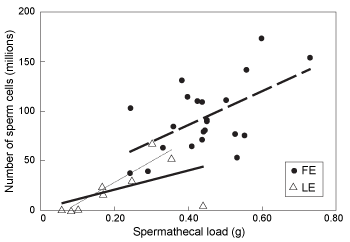
|
Fig. 2. Number of sperm cells and spermathecal load for multiparous female Tanner crab from Glacier Bay, Alaska, hatching and extruding a subsequent clutch in the field (FE; n = 21) presumably after mating (circles), or hatching and extruding a subsequent clutch fertilized with stored sperm in the laboratory (LE; n = 9) without mating (triangles). Linear regression indicated that sperm counts increased significantly (F = 8.99, df = 20, r2 = 0.32, p <0.001) with increasing spermathecal load for FE females (broken line) but did not (F = 2.63, df = 8, r2 = 0.27, p <0.14) for LE (solid line) females including the female with high (0.44 g) spermathecal load and low sperm cell count (4.87 × 106) but did increase significantly (F = 43.6, df = 7, r2 = 0.88, p <0.001) excluding this female (dotted line). Slopes and intercepts were homogenous between the LE and FE groups. See Table 2 for summary of sperm reserves by group. |
|